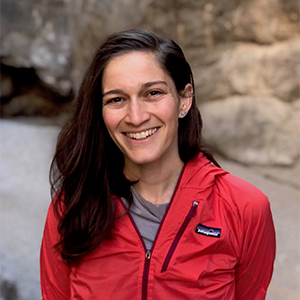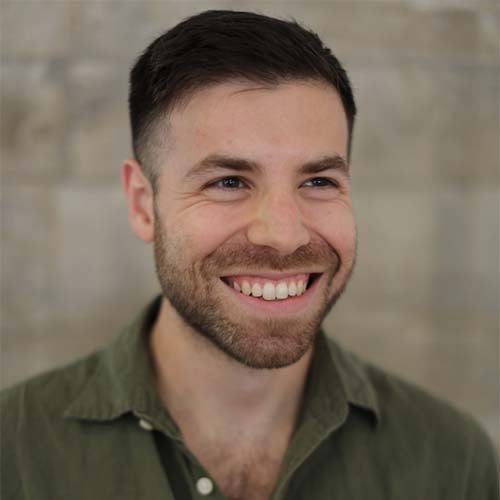Engaging the public in science and technology studies

People participate in "Future Perfect" in February 2020 at the San Francisco Public Library as part of the San Francisco Night of Ideas Festival. Photo courtesy of Julie Ericsson
Research in science and technology studies (STS) goes beyond the traditional books and academic papers. It also includes the practical application of STS and how researchers are bringing those theories and knowledge to the public.
The Making and Doing program at the Society for Social Studies of Science conference highlights this type of research. At this year's conference, two Human and Social Dimensions of Science and Technology students at the School for the Future of Innovation in Society in the College of Global Futures received recognition for their projects.
"Making and Doing embodies the ethos that research should have a social impact," said Assistant Professor Kirk Jalbert, who is on the Human and Social Dimensions of Science and Technology (HSD) committee and part of the Making and Doing panelPanelists were recused from judging submissions from their home institutions.. "How do we do research that can produce generative, positive relationships and make a difference in STS? It's about reflecting on our research practices as researchers. That's something students learn in the HSD program; no matter what the subject is or who they're doing it with, their research has the potential for social impact."
This year's awards recognized five winners and three commendations for how their projects expanded the modes of STS knowledge production and how those projects connected with the conference's theme, "Good Relations: Practices and Methods in Unequal and Uncertain Worlds."
Winner: Noa Bruhis
Productive conversations between people with different backgrounds and values can be challenging, especially on polarizing topics. Human and Social Dimensions of Science and Technology PhD candidate Noa Bruhis is working to solve these communication breakdowns and promote collaboration through her participatory filmmaking project "Helium Rising."
Noa Bruhis
"Helium extraction is happening in northeast Arizona," Bruhis said. "There are various parties involved who have a stake in it and feel very differently about what should be happening, but so far, many of them have found the venues for communication to be unsatisfactory. I am working with these parties to create a public-facing, informational resource about geology, governance and extraction technologies."
The project started as a short documentary for Bruhis' documentary filmmaking class, but she wanted to develop the project further and learn more about how people perceive information. Bruhis collaborates with various stakeholders to create a script and animation based on their different perceptions of helium extraction. The stakeholders then anonymously review the script and animation to share their feedback and whether they believe any language or visuals are misleading.
"I'm engaging people to have conversations in a different way through film. In STS, we call that a boundary object, so they're engaging with the thing instead of each other. I wanted to create a way for each of these parties to feel heard and have a platform to share their views and get their questions answered. I wanted something that everyone could take ownership in, and that would be mutually beneficial for both the community and our research."
The project was also done in partnership with School for the Future of Innovation in Society undergraduate research fellows Beth Keyes and Sakshi Hegde in the CivicFutures lab, created by Jalbert. The lab is a space where students can work collaboratively on projects with other faculty and students to produce high-impact research for public engagement in science. One of Jalbert's goals with the lab is to rearrange the relationship of power in research.
"Why is it that, as researchers, our questions have to be the ones that lead?" Jalbert said. "Why can't the questions and concerns of the community lead our research? That way, researchers in public institutions become what they really should be, public servants."
Bruhis is finishing up the project this semester and then plans to have a workshop where these different groups can come together to discuss their diverse views and work toward forward-thinking resolutions.
"It's such an age-old problem; there are different ways to think about anything," Bruhis said. "People have different values, and there can be friction when they come together. I hope this project can further conversations that lead to collaborative solutions or a shift in the procedure that makes people feel more included."
Commendation: Ben Gansky
Participating in civic engagement can seem overwhelming to some. What's the best way to get involved? Am I "qualified" to debate policy? But in order to create equitable futures, individuals and communities need to get involved. Human and Social Dimensions of Science and Technology PhD student Ben Gansky has designed a fun and interactive way to empower people to become advocates and play a critical role in creating these futures.
Ben Gansky
"Future Perfect is a live, group, choose-your-own-adventure in which participants take on the role of neighborhood council members in an imaginary society called Tomorrowland," Gansky said. "We then unfold this 20-year narrative going into the future. Neighborhood council members are presented with a series of different dilemmas to vote on. We then jump forward in time and find out what happened as a result of their votes and see the cumulative impacts of all the different decisions that the room has made."
Gansky and his team at Free Machine came up with the game as a way to get people more comfortable with civic participation around technology and science policy. They wanted to create a space where people could learn about issues and policies and their significance to their own lives. Experts in the community are brought in to act as the "ministers" of Tomorrowland, weigh in on complex topics and provide concrete calls of action that people can participate in after the game. The game also features volunteers who act as lobbyists and roll a die to give weight to their votes. At the end of the game, the group has guided their society to one of four potential futures based on the combination of abundance or scarcity and equality or hierarchy.
"The game encourages people to think through their own reasoning on those hot-button issues, because it’s not just about voting for the way they think things should be done, but also convincing everyone at their table to vote the same way too. It becomes a way for people to realize that democracy is a team sport," Gansky said.
More Science and technology

ASU professor wins NIH Director’s New Innovator Award for research linking gene function to brain structure
Life experiences alter us in many ways, including how we act and our mental and physical health. What we go through can even…

ASU postdoctoral researcher leads initiative to support graduate student mental health
Olivia Davis had firsthand experience with anxiety and OCD before she entered grad school. Then, during the pandemic and as a…

ASU graduate student researching interplay between family dynamics, ADHD
The symptoms of attention deficit hyperactivity disorder (ADHD) — which include daydreaming, making careless mistakes or taking…

